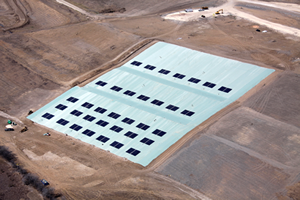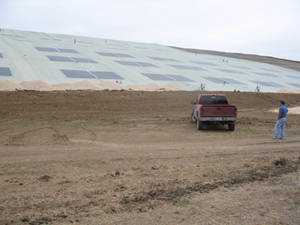|
|
My first serious interest in the possibility of using an exposed landfill cap to generate electricity came in early 2007 when I read articles in Industrial Fabric Products Review (now Specialty Fabrics Review) and Plastics Engineering on the military applications of nanophotovoltaic particles. Although one application was for painting them on fabrics such as used for tents, to generate power for lighting, or even incorporating them in textile fibers, I immediately wondered about incorporating them in the surface layer of a multilayer coextruded geomembrane, in a manner not dissimilar to GSE’s conductive geomembrane.
Now, fast forward to 25 March 2009 when I visited Republic Services Tessman Road Landfill near San Antonio, Texas, just eight days before the high profile ceremony to inaugurate their experimental, exposed landfill cap with solar collector photovoltaic panels attached (Figure 1).
I thank Tony Walker, Project Manager, for arranging my visit and Mitchell Patterson, Environmental Specialist, for showing me around.
The exposed, smooth, reinforced membrane is one of Firestone‘s polypropylene-based thermoplastic polyolefin (TPO) formulations used since the late 1980s. It is 0.060 inches thick, reinforced with a single polyester scrim, and colored green. Its minimum expected service life is 30 years. The exposed cap was installed by American Environmental Group Ltd. (AEG), who also placed the panels. As shown in Figure 2, the membrane lay perfectly flat and, although smooth, there was plenty of friction to walk easily up and down the 15° south facing slopes.
A membrane with good dimensional stability and virtually zero coefficient of thermal expansion is necessary for this application. The membrane was placed on 12 in. of intermediate cover and a compacted grading layer. Thirty 1 ft x 2 ft membrane test panels were attached to the membrane to monitor changes in properties every year for 30 yrs.
The area of the cap is 5.6 acres and the total area of solar cells is 0.5 acres. There are 35 pods with 30 flexible solar modules, for a total of 1050 solar modules. Each module is 15 in. wide x 18 ft long (Figure 3). They will generate electricity in low and high light conditions and at low and high temperatures. The cells have a 20 yr warranty and can easily be changed.
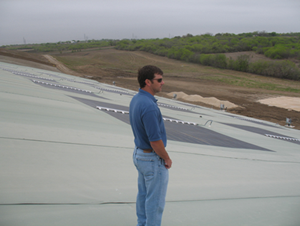 |
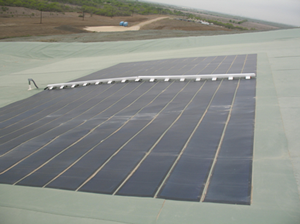 |
The cells are bonded to a peel-and-stick mastic (Sika Lastomer® 68), an ethylene propylene copolymer and therefore very compatible with the TPO. Thus the pod is flexible and able to conform to the cap profile (Figure 4). Each pod was bonded to a large patch of sacrificial TPO membrane on a flat surface, (Figure 5) the assembly moved to the cap, and the TPOs thermally bonded using a 2 in. wide hot-air welder (Figure 6).
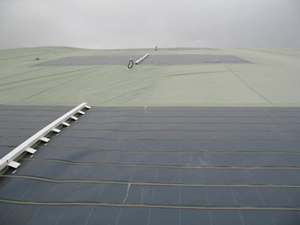 |
 |
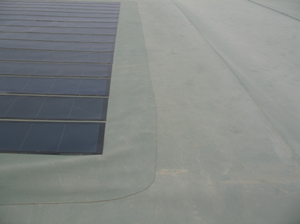 |
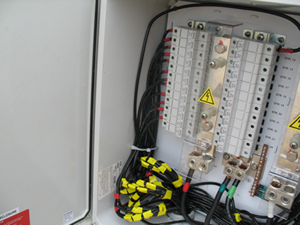 |
The power cables (approximately 0.25 in. diameter) from each pod are led under the liner to a five-pod array connections panel box (Figure 7) at the edge of the cap. From thence they go to an inverter box (Figure 8).
Each string of five pods and 10 panels stacked up the slope generates 400 VDC (~4 amps) which is inverted to 3-phase 480 VAC. Total annual energy output is 180,000 kWh.
Unlike the well-known Delaware Solid Waste Authority South Landfill exposed geomembrane cap (EGC) with many precipitation run-off flow-controlling benches and channels (Figure 9), but more like the three Florida EGCs (Polk Co. [HDPE], Marion Co. [LLDPE], and New River Regional [HDPE]), the Republic exposed cap is designed for sheet flow run-off. To date such flow has been very well-behaved. No doubt the micro-textured surface of the membrane contributes to this positive performance characteristic.
HDR designed the cap.
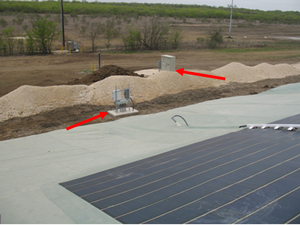 |
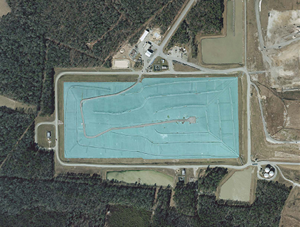 |
There is no doubt we will see more of these installations that harness power from both under and over the exposed membrane cap. There will be further development of integrated systems and composite membranes. Flexible solar cells bonded directly to a membrane are an improvement over the rigid cells placed some distance above the membrane, for cooling, as shown in Figure 10. On the other hand, cooling can be achieved by placing the solar cells on a floating cover, as in Figure 11.
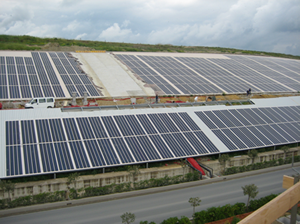 |
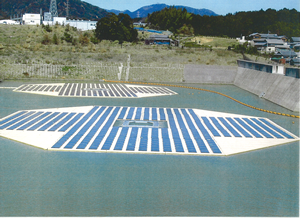 |
But the neat objective would be to blend those photovoltaic nanoparticles into or onto the surface layer of a geomembrane during a geomembrane manufacturing process.
Geosynthetica will be pleased to receive and publish any news and case histories of nonconventional applications of geosynthetics. Please contact Chris Kelsey at chris@geosynthetica.net.
Ian D. Peggs, Ph.D., P.E., P.Eng., is president of I-CORP INTERNATIONAL Inc. He can be reached at icorp@geosynthetic.com.
